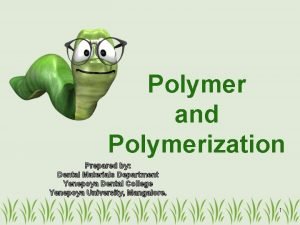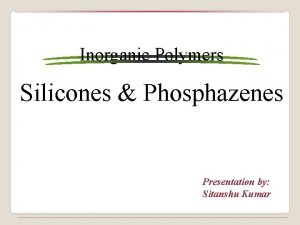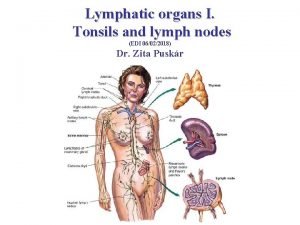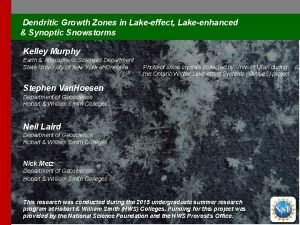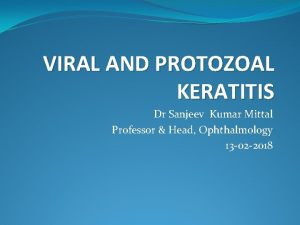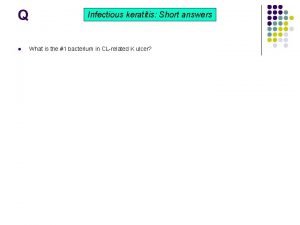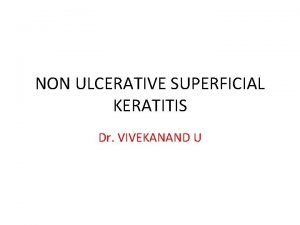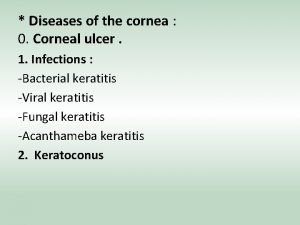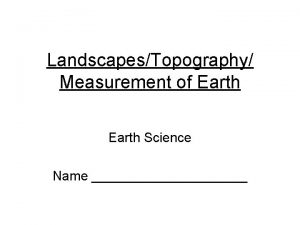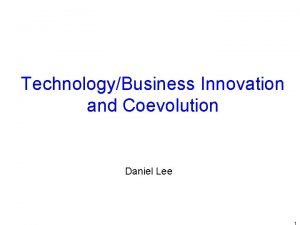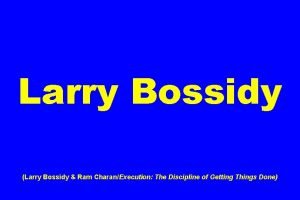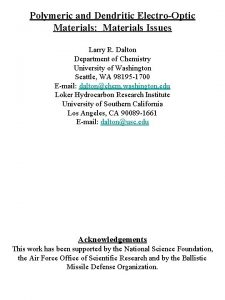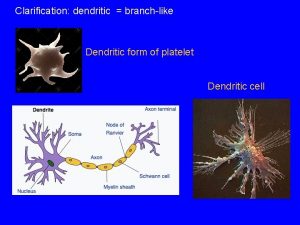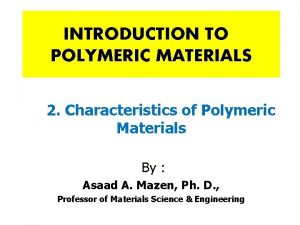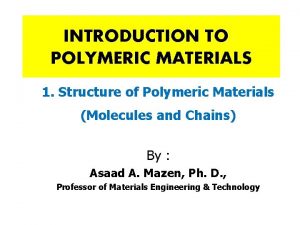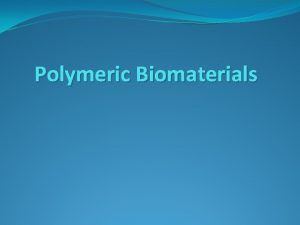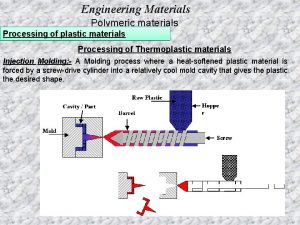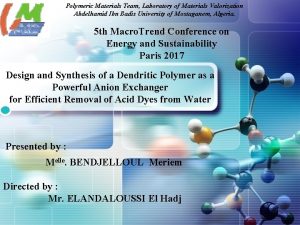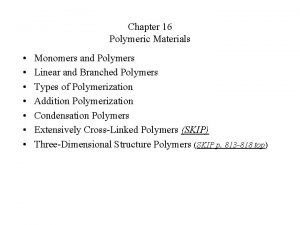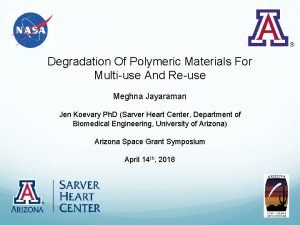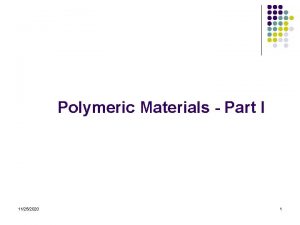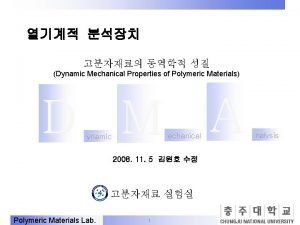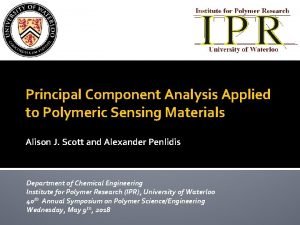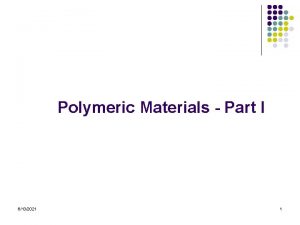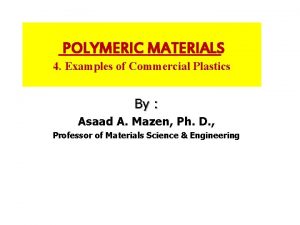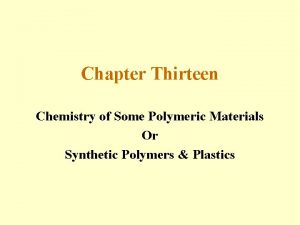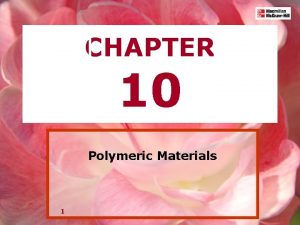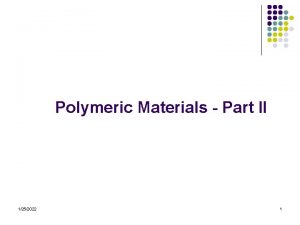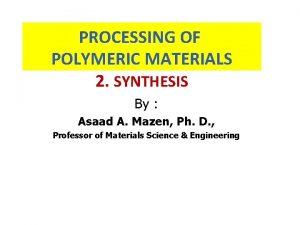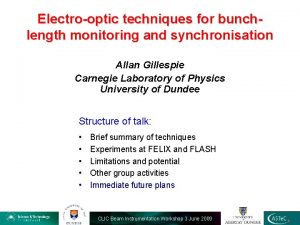Polymeric and Dendritic ElectroOptic Materials Materials Issues Larry




















- Slides: 20

Polymeric and Dendritic Electro-Optic Materials: Materials Issues Larry R. Dalton Department of Chemistry University of Washington Seattle, WA 98195 -1700 E-mail: dalton@chem. washington. edu Loker Hydrocarbon Research Institute University of Southern California Los Angeles, CA 90089 -1661 E-mail: dalton@usc. edu Acknowledgements This work has been supported by the National Science Foundation, the Air Force Office of Scientific Research and by the Ballistic Missile Defense Organization.

Why Organic Electro-Optic Materials? • BANDWIDTH. Device bandwidths of 113 GHz have been demonstrated and intrinsic materials bandwidths are on the order of 365 GHz. Response defined phase relaxation time which is on the order of femtoseconds. Pi electron system defines both dielectric permittivity and index of refraction--electrical and optical fields propagate at the same velocity thus long interaction lengths possible. • ELECTRO-OPTIC ACTIVITY. Electro-optic coefficients of 60 -100 pm/V (at telecommunication wavelengths of 1. 3 and 1. 55 microns) are now routinely realized. These have lead to Vp voltages of less than 1 volt. Such values are critical for lossless telecommunication links. • PROCESSABILITY. Excellent processability has led to 3 -dimensional active/passive optical circuitry that can be effectivlye integrated with VLSI semiconductor electronics and silica fiber optics. Electro-optic materials are inherently conformal and capable of being designed for compatibility with virtually any surface. • LOW PERTURBATION. The low dielectric permittivity of organic materials affords minimum perturbation of radiofrequency fields of relevance to applications such as sensing. Power dissipation is minimal as are problems with crosstalk between electro-optic circuit elements.

Potential Problems? • OPTICAL LOSS. Optical loss of organic electro-optic waveguides are typically on the order of 1 -2 d. B/cm which is marginal. Optical loss values as low as 0. 2 d. B/cm (comparable to lithium niobate) have been obtained. This issue has not been the focus of much attention. With attention from the synthetic community, it will likely not be a problem. • THERMAL STABILITY. Thermal decomposition of materials is not a problem. Chromophores are typically stable to more than 300°C (which is more than adequate). Rotational relaxation of poling-induced order is an on-going concern. Composite materials generally are not adequate unless the host has a very high glass transition temperature. Chemical lattice hardening a viable answer to improved stability with stability to 200°C realized in some instances. Unfortunately, lattice hardening is typically achieved at the price of some attenuation in electro-optic activity. • PHOTOCHEMICAL STABILITY. Singlet oxygen mechanisms are a problem. Simple packaging leads to viable stability (ability to withstand 50 m. W power input into EO waveguides for periods of months). Elimination of oxygen would certainly lead to viable materials as other mechanisms, such as two photon absorption, appear to be ineffective. O 2 forms strong VDW complexes with chromophores; simple degassing not effective in eliminating oxygen. Exclusion of oxygen must start during chromophore synthesis. Lattice hardening and incorporation of scavengers also helpful.

Organic Electro-Optic Materials Issues and Status of Synthesis of Materials -Chromophores: Issues: Optimization of hyperpolarizability; minimization of optical absorption; optimization of thermal stability; control of solubility and processability; optimization of chemical and photochemical stability Status: m values of greater than 10 -44 esu are now routine, absorption typically 0. 8 d. B/cm but values as low as 0. 2 d. B/cm have been obtained; thermal stability to 300°C is routine; adequate processability is routinely realized. -Bulk Materials: Issues: Optimization of macroscopic electro-optic activity; minimization of material optical loss from both absorption and scattering mechanisms; optimization of thermal stability of electro-optic activity; optimization of photochemical stability. Status: Electro-optic coefficients in the range 60 -100 pm/V (at 1. 3 -1. 55 mm) routinely obtained; optical loss of 1 -2 d. B/cm typical but values as low as 0. 2 d. B/cm have been realized; in composite materials thermal stability is less than 100°C but with lattice hardening values of 120 -150°C are easily realized; photochemical stability in the presence of atmospheric oxygen is not acceptable but simple packaging appears to lead to adequate stability. Materials are clearly adequate for prototype device development but all necessary properties have not been realized in a single material as is required for commercialization. Realization of a commercial material appears very likely.

Organic Electro-Optic Materials Issues and Status of Materials Processing -Wavguide Fabrication: Issues: Fabrication of buried channel waveguides exhibiting minimum optical loss; fabrication of sophisticated three dimensional circuitry. Status: Reactive ion etching and photolithographic methods have been optimized to the point of yielding waveguides with excess loss on the order of 0. 01 d. B/cm. Use of gray scale, offset, and shadow ion mask lithographic techniques has permitted the fabrication of sophisticated 3 -D circuits with insignificant excess loss. Post fabrication photochemical trimming of circuit performance has been demonstrated. -Integration of EO Waveguides: Issues: Minimization of mode mismatch coupling losses for integration with silica fiber optics; maximization of bandwidth and minimization of loss for integration with drive electronics. Status: Several schemes (up coupling into EO wedges and use of spherical lens) have been employed to demonstrate low loss optical of silica and polymeric EO waveguides. The use of such schemes in a commercial structure remains to be demonstrated. Several high bandwidth integrated structures have been explored. Device operation to 113 GHz has been demonstrated and 220 GHz operation may be possible in the near future. Integration of polymeric EO circuitry with VLSI semiconductor electronics for low bandwidth operation has been convincingly demonstrated. Commercially-relevant integration for high bandwidth operation not yet demonstrated but likely viable.

Organic Electro-Optic Materials Cladding Materials -Issues: The cladding material must prevent the propagating optical wave from seeing the lossy metal electrodes. The cladding material should have a higher electrical conductivity so that poling and drive fields are dropped across the cladding layer(s) to permit the electro-optic chromophores to see the largest possible effective field. Cladding materials must be photochemically and thermally stable. Cladding materials must not be subject to photoconductivity effects that could cause instability in device operation. Cladding must not themselves contribution to optical loss. In short many of the same issues that apply to the active core materials apply to cladding materials. -Status: Very little attention has been paid to the performance of cladding materials. Almost all prototype devices have been fabricated with off the shelf commercial epoxy materials (thermally and UV-curable epoxies). The only attention paid to conductivity issues is the work carried out at AFRL-Wright Patterson AFB and at Lockheed Martin. These researchers have demonstrated that improvement in device Vp performance can be achieved with attention to cladding conductivity. More research is required to demonstrate the commercial relevance of development of custom cladding materials. General conclusion: An important but neglected area of research.

Organic Electro-Optic Materials A Historical Perspective • Quantum mechanics has guided the systematic improvement of molecular hyperpolarizability shown below. Chromophore dipole moment-molecular hyperpolarizability product (m ) values of greater than 10 -44 esu are now routinely achieved This improvement has be achieved without sacrifice of thermal and chemical stability (e. g, the decomposition temperature of the FTC chromophore is approximately 325°C). .

Organic Electro-Optic Materials A Historical Perspective • Improved molecular hyperpolarizability has been exploited with the development of statistical mechanical calculations to guide the transitioning of molecular second order optical nonlinearity into macroscopic electro-optic activity leading to improvements shown below:

Organic Electro-Optic Materials A Historical Perspective • In 1996 it was realized that intermolecular electrostatic interactions were inhibiting the efficient translation of molecular EO activity to macroscopic EO activity. These interactions resulted in a maximum in the plot of EO activity reverse chromophore loading in the host polymer matrix. The position of this maximum shifts to lower loading with increasing chromophore dipole moment and hence dipole moment-hyperpolarizability product. The attenuation of electro-optic activity is most severe for prolate ellispsoidal chromophores and less severe for more spherical chromophores. Statistical mechanical calculations predicted that intermolecular electrostatic interactions would lead to this behavior and motivated the experimental investigations shown below:

Organic Electro-Optic Materials A Historical Perspective • Statistical mechanical calculations suggested a new paradigm optimization of electro-optic activity: Control chromophore shape! CLD-2 CLD-3 Disperse Red (1995) ®

Organic Electro-Optic Materials A Historical Perspective

Organic Electro-Optic Materials A Historical Perspective • Materials with improved electro-optic activity have been used to fabricate a number of prototype devices including: (1) phased array radars; (2) spatial light modulators/laser beam steering devices; (3) broadband high stability oscillators; (4) acoustic spectrum analyzers; (5) polarization-insensitive signal transducers (modulators); (6) time stretchers and compressors (ultrafast A/D converters); (7) optical gyroscopes; and (8) high bandwidth optical switches. Some selected references are given below: Acoustic Spectrum Analyzer: IEEE Selected Topics in Quantum Electronics, Vol. 6, pp. 810 -6 (2000). Photonically Controlled RF Phase Shifter: IEEE Microwave and Guided Wave Letters, Vol. 9, pp. 357 -9 (1999). 102 GHz Time Stretching: IEEE Photonics Technology Letters, Vol. 12, pp. 537 -9 (2000). Spatial Light Modulators: Proceedings SPIE, Vol. 3950, pp. 98 -107 (2000). Sub 1 Volt modulation (Science, Vol. 288, pp. 119 -22 (2000)) is shown below:

Organic Electro-Optic Materials What Is Required For Further Material Improvements And What Can Be Expected In the Near Term? • The improvements of the past four years have been realized exploiting a theoretically derived paradigm. Current theory suggests that further improvements are clearly possible. Indeed, electro-optic values in the range of 100 -200 pm/V are a realistic target. Improved theory is the first step toward this target. Two theoretical advances are required: (1) Development of simple theory that is easily utilized by those synthesizing chromophores. This development would be analogous to the development of the simple two state quantum mechanical model of molecular hyperpolarizabilities by Marder and Perry. (2) Development of theory, such as atomistic Monte Carlo methods, capable of treating complex electro-optic materials structures such as multi-chromophorecontaining dendrimers such as shown in the text slide. Crosslinked versions of such multi-choromophore dendrimers have yielded electrooptic activities two to three times that of lithium niobate at 1. 55 microns while exhibiting material optical loss of 1 d. B/cm or less. The electrooptic activity for such materials has been observed to be stable for 1000 hours at 85°C. All preliminary studies point to continued dramatic improvements; however, dendrimer structures are very complex and the folding of dendrimer structures is critical in determining observed materials properties. Dendrimer structures also appear optimum for improving intrinsic photochemical stability both by restricting diffusion of reactive species and by judiciously positioning scavenging agents. Dendrimers appear to lead to improved poling dynamics potentially because chain entanglements of linear polymers are avoided. Segmental flexibility of dendrimers can be controlled to be less problematic for chromophore rotational relaxation.

Organic Electro-Optic Materials The Future: A Multi-Chromophore Dendrimer Ma, Chen, Takafumi, Dalton, and Jen, Journal of the American Chemical Society, 123, 986 (2001).

Recent Advances in Analytical Theory & Comparison With Monte Carlo Calculations We explore the development of both analytical and numerical results and will discuss the relationship between these. The principal electro-optic coefficient tensor element, r 33, is related to the acentric order parameter, <cos 3( )>; the first molecular hyperpolarizability, ; the chromophore number density in an inert host, N; the index of refraction, n; and the local field arising from the host dielectric permittivity, f( ), by r 33 = N<cos 3( )>2� f( )/n 4 (1) For a homogeneous, single-phase material, the number density is related to the mean distance between chromophores, r, as N = 1/r 3. Consider an ensemble of M chromophores. Statistical mechanics provides a method of computing the mean order from the M particle energy, U(r(M), Ep), including the effect of a uniform electric poling field, Ep. (M) are the two (or three) Euler angles that define the directions of the M chromophores. The order parameter can be computed from a consideration of all interactions contributing to the total energy according to <cos 3( )> = ∫ � cos 3( )G(r, (M), Ep)dr. Md M/∫ � G(r, (M), Ep)dr. Md M (2) where G(r, (M), Ep) = exp(-(U(r(M), Ep)/k. T) is the M-particle partition function and k. T is thermal energy. From an analytic perspective this is a difficult problem. To make progress, we suggest that a single chromophore (designated as “ 1”) be the one for which averaging is done. We then average over all other chromophores. The non-normalized probability distribution around the first chromophore is then PM( 1), where PM( 1) = ∫G(r, , Ep) dr. Md M-1. The average order is then cos 3( �)> = ∫ � cos 3( �)PM( 1) d 1 /∫ � PM( 1) d 1 (3)

Here we deviate from the standard statistical mechanical treatment of the pairwise interaction of particles and follow Piekara’s treatment of a many body interaction among particles. Piekara suggested that the bulk material consists of many solidus regions that cannot interconvert. The orientation 1 is composed of two rotations: 1 = + M, which is rigorously true when the minor angles are equal. More generally, the Euler angles are related formally as 1 = M. Thus, the angle 1 is related to the other Euler angles by cos( 1) = cos( )cos( M) + sin( )sin( M)cos( - M). PM( 1) is the product of two terms: (1) the distribution of chromophore 1 with respect to the center of symmetry of the local solidus and (2) the interaction of chromophore 1 with the poling field. Therefore, the averaging over the orientations of 1 must be done in two steps. The first is the averaging over the effective field around chromophore 1 due to the other M-1 chromophores. Hence, <cos 3( )>M = ∫ cos 3( )PM( 1) d 1 /∫ PM( 1) d 1 (4) This average must then be averaged over all according to <cos 3( )> = (1/8 2)∫ <cos 3( )>M d (5) Piekara suggested a specific form for PM( 1) as PM( 1) = (1/4 )exp(-fcos )exp(-wcos M) (6) Where w is an undetermined constant independent of the poling field. f = Ep/ k. T. Here is the chromophore dipole moment and is the dielectric permittivity. The first exponential of Eq. 6 is due to the poling field on chromophore “ 1” and the second term is the leading term in an expansion of the effect of all other chromophores in the vicinity of chromophore 1 on “ 1”. With this definition of the single particle probability distribution, we can evaluate the following integral G(z) = sinh(z)/z = (1/4 ) ∫cos ∫ exp(-fcos )exp(-wcos M) dcos Md M = ∫ PM( 1) d M (7) G(z) is the generating function for the rest of the integration. Moreover, z is the magnitude of the vector sum of the poling field and the local crystal field z 2 = f 2 + w 2 + 2 fwcos( ) (8)

This result demonstrates the vectorial nature of the interaction of the local crystal field with the poling field. The poling field-dipole interaction energy of the simple Langevin theory is now replaced with the interaction energy of the vector sum of the local interaction field with the poling field. The final averaged quantity of interest can then be determined using the generating function. <cos 3( )> = (1/2)∫cos (1/G(z))[∂3 G(z)/∂3 f]dcos (9) The integrand can be evaluated and written as an analytic function of z. The integrand can be written in terms of the first Langevin function, L(z), with z as the argument. L(z) = coth(z) – (1/z) (10) Explicitly, the order parameter can be expressed as <cos 3( )> = (1/2)∫cos (f + wcos( ))[A + B]dcos (11) A = 3{[(3/z)L(z) – 1]/z 2} (11 a) B = (f + wcos( ))2{[5 – (z 2 + 15)(L(z)/z)]z 4} (11 b) Here the two groupings of L(z) make the functional forms numerically stable at small z. This integrated may be numerically evaluated in this form. The integrand is analytic and finite everywhere. A reasonable form for w is suggested by London; namely, w = ( 2/r 3 k. T)2 = (N 2/k. T)2 (12) Two approximate solutions of Eq. 11 are easily written. For f < k. T, Eq. 12 becomes <cos 3( )> = (f/(5){1 – L 1(w)2} (13 a) For w < k. T, Eq. 12 becomes <cos 3( )> = L 3(f){1 – L 1(w)2} (13 b)

The two approximations are bounded everywhere by the exact solution of Eq. 12. The term in brackets is referred to as the attenuation factor. The first factor is independent of N while the attenuation term decreases with increasing concentration as 1 -L 1(N)2. Since r 33 varies as f( )N<cos 3 >/n 4, a maximum is predicted in the plot of electro-optic coefficient versus N. The value of N leading to maximum EO activity is given (for normal poling field strengths) by Nmax = (√ 1. 91)/( 2/k. T) (14) illustrating the simple scaling with chromophore dipole moment, . Eq. 14 works surprising well for experiments employing typical poling fields. However, analytical expressions can also be derived that explicitly include the poling field, f, dependence. The effect of chromophore shape may be approximately treated as the interaction of two hard sphere ellipsoids separated by distance r. The mean intermolecular distance is determined from the number density as given above. However, if the ellipsoids are prolate then they both cannot point along the line joining their centers if the concentration is in a regime where 2 a > r > 2 b. Here a and b are the major and minor semi-axes of the prolate ellipsoid. In this regime, there is a constraint on the angles accessible to an ellipsoid before colliding with a neighbor (at the same orientation). The orientation of the molecular is found from the x and y distances form the center to the surface: x 2 + y 2 = (r/2)2. The equation for the surface of the ellipse is (x/b)2 + (y/a)2 = 1. From these two equations and two unknowns, the cutoff or the minimum angle that can be obtained as a function of r: c = c(r) = cos( min) = {1 – (2 b/r)2}/{1 – (b/a)2}. A similar expression is found ffor the oblate ellipsoid case. The cutoff function, c(r), is a continuous function of r or N because c(r) = 1 for r > 2 a and c(r) = 0 for 2 b > r. This minimum angle can be incorporated into the evaluation of the order parameters by restricting the limits of integation so that –c ≤ cos( M) ≤ c. The integral of the generating function, Eq. 7, is then evaluated between these limits rather than between – 1 and +1. This integral can be evaluated and shown to yield Gc(z) = c[cos ( )G(cz cos( ))exp(zsin( min)sin( )] (15) Therefore, this restriction on the integration over this one angle just scales the value of z or the vectors connecting the two terms. Hence, the average quantities may be evaluated in a similar manner as before. Application of this simple approximate treatment to data obtained for the CLD chromophore is shown in the accompanying figure.

Comparison of experimental (solid diamonds) and theoretical data for the CLD chromophore in polymethylmethacrylate is shown. The dashed line shows the result (discussed in the text) of considering only electronic electrostatic interactions. The dotted line shows the influence of steric effects, the c(r) parameter discussed in the text. The solid line shows the combined effect of these two types of interactions. Note that as expected, electronic interactions are longer range (the maximum value occurs at lower number density). Note that all calculations are executed without adjustable parameters. For the purposes of these calculations, the chromophore shape was approximated by a prolate ellipsoid. Improvement in agreement between theory and experiment can be achieved by self-consistent treatment of the effect of chromophore concentration on material (host polymer) dielectric permittivity. Surprisingly good reproduction of experimental data is obtained even with the simple model discussed in the text.

This simple approximation works surprisingly well for relatively stiff electro-optic chromophores and yields essentially quantitative reproduction of experimental data for many chromophores. The approximate theory provides very valuable guidance to the optimization of macroscopic electro-optic activity. It provides a simple expression for calculating the chromophore loading that will lead to optimum electro-optic activity. It also indicates that electro-optic activity can be optimized by making prolate ellipsoidal chromophores more spherical. We have sought to test the approximations of simple theory and to gain insight into the details of the chromophore distributions by carrying out Monte Carlo calculations. A variety of such calculations have been carried out at different levels of approximation. We briefly describe the most simple variant here. In this treatment, individual chromophores are placed at lattice sites, one per site in an ordered array. For the case of a simple cubic lattice, the dipoles are placed M by M, where values of M from 10 through 13 are typically examined. The lattice is then embedded in images of itself to avoid end effects (i. e. , re-entrant boundary conditions). The statistical effective field is then found around each dipole from the histogram of all relative orientations, , due to the nearest neighbor dipoles, j, around each and every individual dipole i. The histogram generated from the Monte Carlo calculations is well fit to the functional form P( ) = A{exp(-0. 3 wcos( ) + Bexp(0. 3 wcos( )} (16) where B is approximately 1/3. This expression is nearly in quantitative agreement with the potential function proposed by Piekara. The value of 0. 3 in the exponential of Eq. 16 accounts for the 26 nearest neighbors weighed by those diagonally related to the central one. Monte Carlo calculations also establish that w follows a fourth power dependence on chromophore dipole moment. The theoretical results presented here clearly provide motivation for pursuing development of approximately spherical chromophore by synthetic approaches such as dendritic methods. The segmental flexibility of dendrimers argues for atomistic kinetic Monte Carlo methods to assure that chromophores are held in an appropriate nanostructured array. In the course of using statistical mechanical methods to optimize electro-optic activity, it became clear that control over molecular structure could be used to control processability (solubility in spin casting solvents), optical loss, chemical stability, thermal stability, and photochemical stability.
 Polymer in dentistry
Polymer in dentistry Silicones and phosphazenes notes
Silicones and phosphazenes notes Transversion
Transversion Tonsillar hemicapsule
Tonsillar hemicapsule Dendritic growth zone
Dendritic growth zone Hutchinson sign eye
Hutchinson sign eye Dendritic keratitis
Dendritic keratitis Diffuse superficial keratitis
Diffuse superficial keratitis What are deficiency
What are deficiency Herpes zoster
Herpes zoster Corneal ulcer
Corneal ulcer Cross sectional shape of earth
Cross sectional shape of earth Natural materials
Natural materials What is a material useful
What is a material useful Man made materials
Man made materials Adopting materials
Adopting materials Dgp week 17
Dgp week 17 Griffin ford model example city
Griffin ford model example city 7:30
7:30 Overtake
Overtake Discipline of ram
Discipline of ram
